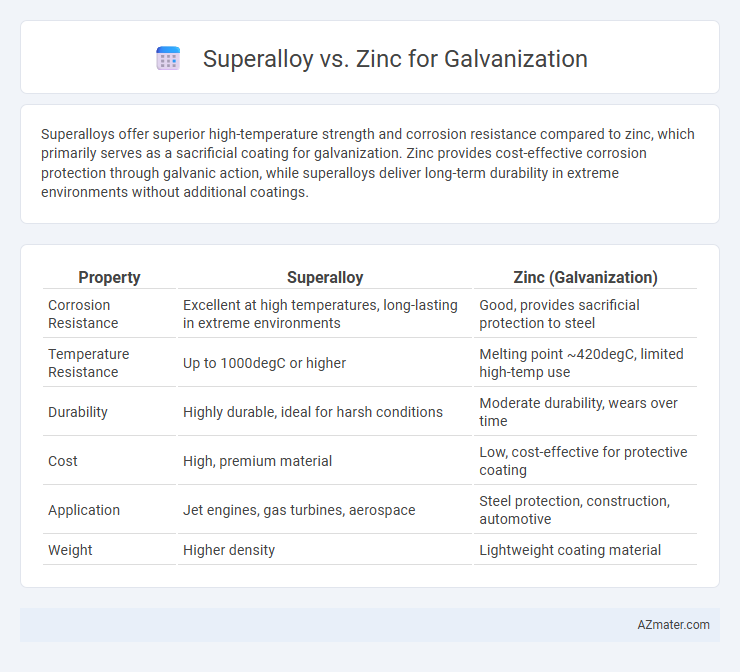Superalloys offer superior high-temperature strength and corrosion resistance compared to zinc, which primarily serves as a sacrificial coating for galvanization. Zinc provides cost-effective corrosion protection through galvanic action, while superalloys deliver long-term durability in extreme environments without additional coatings.
Table of Comparison
| Property | Superalloy | Zinc (Galvanization) |
|---|---|---|
| Corrosion Resistance | Excellent at high temperatures, long-lasting in extreme environments | Good, provides sacrificial protection to steel |
| Temperature Resistance | Up to 1000degC or higher | Melting point ~420degC, limited high-temp use |
| Durability | Highly durable, ideal for harsh conditions | Moderate durability, wears over time |
| Cost | High, premium material | Low, cost-effective for protective coating |
| Application | Jet engines, gas turbines, aerospace | Steel protection, construction, automotive |
| Weight | Higher density | Lightweight coating material |
Introduction to Galvanization Materials
Galvanization materials primarily include zinc and superalloys, each offering distinct corrosion resistance properties. Zinc is widely used due to its sacrificial anode characteristic, protecting steel through galvanic corrosion prevention. Superalloys, composed of high-performance metals like nickel, chromium, and cobalt, provide enhanced durability and resistance in extreme environments, making them suitable for applications requiring superior longevity and strength.
Understanding Superalloys: Properties and Applications
Superalloys exhibit exceptional high-temperature strength, corrosion resistance, and oxidation resistance, making them ideal for aerospace, power generation, and chemical processing industries. Unlike zinc used in galvanization, which primarily protects steel by sacrificial coating against rust, superalloys maintain structural integrity under extreme conditions. Their complex composition, often containing nickel, cobalt, or iron, enhances durability and performance beyond the capabilities of standard galvanizing materials.
Zinc in Galvanization: Core Benefits
Zinc in galvanization offers superior corrosion resistance by forming a protective oxide layer that prevents rusting, significantly extending metal lifespan. Its self-healing properties ensure continuous protection even if the coating is scratched or damaged. Zinc coatings provide excellent adhesion, cost-effectiveness, and environmental sustainability, making them a preferred choice in industrial and construction applications over superalloys.
Corrosion Resistance: Superalloy vs Zinc
Superalloys exhibit superior corrosion resistance compared to zinc due to their high content of corrosion-resistant metals such as nickel, chromium, and cobalt, which form stable oxide layers protecting the surface. Zinc provides sacrificial protection in galvanization by corroding preferentially to steel, but it has limited durability in harsh environments and can degrade more quickly under acidic or saline conditions. Therefore, for long-term corrosion resistance, superalloys outperform zinc coatings, especially in extreme or aggressive atmospheres.
Mechanical Strength and Durability Comparison
Superalloys exhibit significantly higher mechanical strength compared to zinc, making them ideal for applications requiring superior load-bearing capacity and resistance to deformation. Zinc offers moderate durability primarily through its sacrificial corrosion protection in galvanization, effectively extending asset lifespan but lacking the inherent structural robustness of superalloys. The choice between superalloy and zinc depends largely on whether corrosion resistance or mechanical performance is the critical factor in the application.
Cost Analysis: Superalloy vs Zinc
Superalloys typically incur significantly higher costs than zinc due to their complex composition and specialized manufacturing processes, making them less economical for large-scale galvanization projects. Zinc remains the preferred choice for galvanization because of its affordability, widespread availability, and effective corrosion resistance. Cost efficiency of zinc galvanization supports its extensive use in infrastructure and automotive industries, whereas superalloy applications are limited to critical environments requiring exceptional durability.
Environmental Impact of Both Materials
Superalloys, primarily composed of nickel, cobalt, and chromium, exhibit lower environmental impact during galvanization due to their high corrosion resistance, resulting in less frequent re-coating and reduced metal waste. Zinc galvanization, while energy-intensive in extraction and processing, offers excellent sacrificial protection that extends the lifespan of steel structures, minimizing steel consumption and waste over time. However, zinc mining and smelting release significant amounts of heavy metals and greenhouse gases, making superalloy coatings more sustainable in long-term environmental assessments.
Lifespan and Maintenance Requirements
Superalloys offer superior lifespan compared to zinc in galvanization due to their enhanced resistance to high temperatures, corrosion, and mechanical stress, making them ideal for demanding industrial applications. Zinc coatings provide effective corrosion protection but tend to degrade faster, requiring more frequent maintenance and reapplication to preserve their protective qualities. The maintenance requirements for superalloy components are significantly lower, reducing downtime and long-term costs in environments prone to chemical exposure and extreme conditions.
Industry Applications: Which Material Is Best?
Superalloy and zinc serve distinct purposes in galvanization within industry applications, where zinc offers superior corrosion resistance through sacrificial protection for steel structures commonly used in construction and automotive sectors. Superalloys, composed of nickel, cobalt, and chromium, provide exceptional high-temperature strength, making them ideal for aerospace and power generation components requiring durable surface treatments beyond basic galvanization. Selecting the best material depends on application-specific demands for corrosion protection versus thermal and mechanical performance in challenging environments.
Conclusion: Choosing the Right Material for Galvanization
Superalloys offer superior corrosion resistance and mechanical strength for galvanization in extreme environments, making them ideal for aerospace and high-performance industrial applications. Zinc remains the preferred material for galvanization in general applications due to its cost-effectiveness and excellent sacrificial protection against rust. Choosing the right material depends on balancing environmental conditions, budget constraints, and required durability to ensure optimal long-term performance.

Infographic: Superalloy vs Zinc for Galvanization
 azmater.com
azmater.com